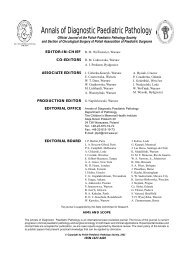annals 1-2.qxd - Centrum Zdrowia Dziecka
annals 1-2.qxd - Centrum Zdrowia Dziecka
annals 1-2.qxd - Centrum Zdrowia Dziecka
You also want an ePaper? Increase the reach of your titles
YUMPU automatically turns print PDFs into web optimized ePapers that Google loves.
40<br />
A<br />
D<br />
B<br />
C<br />
Fig. 1 Demonstration of histological changes in biliary atresia<br />
A. Cholestasis in zone 3, focus of hematopoesis (H&E)<br />
B. Giant cell transformation (H&E)<br />
C. Severe fibrosis (H&E)<br />
D. Features of ductal plate malformation CK7 and CK 19 (EnVision)<br />
Discussion<br />
The distribution of cholestasis was significantly different<br />
in both groups (Fig. 1A). Cholestasis in zone 1 was seen<br />
in all cases, but regular in zone 2 and 3 in the first group<br />
and was statistically different from the second group. Chi-<br />
-square Independence test and Kolmogorov-Smirnov test<br />
performed on liver specimens from patients with the first<br />
unfavorable group and the second favorable group (significance<br />
level 0.05) showed dependency between cholestasis in<br />
zone 2 and 3.<br />
There are two clinical forms of biliary atresia: embryonic and<br />
perinatal. The embryonic type occurs in 35% of patients, is<br />
characterised by early onset of neonatal cholestasis without<br />
jaundice free period and ductal plate remnants are often present<br />
in the liver. The perinatal type occurs in 65% of patients,<br />
has a later onset of cholestasis and jaundice free period may<br />
be present after physiological jaundice. The proposed prognostic<br />
factors after Kasai procedure include age at operation,<br />
ductal size at porta hepatic, grade of liver fibrosis, ductal plate<br />
malformation and ductular proliferation [7, 9, 16]. Our<br />
work based on the retrospective selection of patients at the same<br />
age during Kasai procedure, but different survival with native<br />
liver. The grade of fibrosis was similar in both groups and<br />
we didn`t observe any cirrhotic changes, and age of the patients<br />
ranged from 31 to 69 days. Some authors believe that<br />
hepatic fibrosis, rather than age, is an important prognostic<br />
factor [14]. In our material, two infants who underwent Kasai<br />
hepatoportoenterostomy at the age of 31 and 39 days, pro-

















